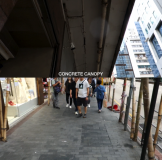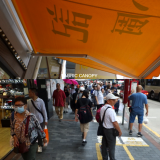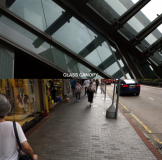Introduction
The canopy, a distinctive characteristic of traditional Hong Kong tenement buildings, sadly faces disappearance in the near future as international and modern building styles continue to emerge. These traditional buildings, typically a few stories tall and tightly packed along city roads, have limited land area and are often connected to street level. The ground floor is commonly occupied by shops and walkways. Furthermore, due to Hong Kong’s geographical location, it results in frequent rainy weather during the summer, making the canopy a practical outdoor roof that provides shelter. The primary purpose of the canopy has remained relatively consistent, continuing to protect pedestrians from rain and sunlight. It is treated as a public element of the city.
However, it is worth noting that many of the first-floor residents have made modifications to the canopy since its construction. They have recognized the canopy as a gift from the developer and have transformed its function from a public element to a private one. By digging through walls, adding extra doors, and railing the edges of the canopy, residents have turned it into a balcony for relaxation, clothes hanging, and additional storage space. This gradual extension of the canopy’s function has provided households with an additional livable area, despite its original intent. These modifications often go against legal restrictions, yet it is fascinating to observe how people utilize previously unused space by creating access to the canopy through walls and railing its edges, or simply leaving them unrailed.
In this video essay, I will explore the interactions at street level between pedestrians and the canopies, studying human activities and highlighting this often unnoticed feature that serves the public on a daily basis. I believe that the canopy should be preserved in new designs and further improved with modern techniques and styles.
Methodology
Primary and secondary research were both utilized in the production of the film. Multiple fieldwork and observations were conducted to understand the construction, and design of canopies. Additionally, secondary research was conducted to learn about the history and design of canopies. Through this research, I gained a better understanding of the canopies, including their general design of a hollow under area of concrete to minimize weight and a slightly slanted top concrete slab to allow water to flow down. This provided me with a solid basis for analyzing and documenting canopies around Mongkok.
The area was chosen due to its richness in the typologies of buildings. There is a mix of new and old buildings, most of which have the feature of a canopy due to the narrow streets. From filming and observing, I was able to produce a library of canopies and study them further after processing the materials. This allowed me to identify unique characteristics of each canopy and understand how they contribute to the overall streetscape. By conducting both primary and secondary research, I was able to gain a comprehensive understanding of canopies and their importance in the public environment.
Producing the video
The video was filmed in two parts, with the top part solely focusing on the canopy and the bottom part focusing on the streets and pedestrians. The intention behind the isolation of elements was to refocus the attention on the investigation and observe human behaviors under the canopy. I deliberately chose a day with slight raindrops to observe, and while many were holding umbrellas, almost no one was using them, thanks to the canopy. From observing, the canopies are almost invisible to people, despite creating a semi-private space. This is in contrast to undercover walkways or pavilions, where people tend to look up and observe.
To create the library of canopies, subtitles were added to classify the different types, such as concrete, glass, and fabric canopies, based on their purpose and characteristics. Concrete canopies are the most conventional, but as modernization increases, newer designs like glass canopies are also appearing. While lacking sunproof features, glass canopies are more aesthetically acceptable and can blend in with the facade. Fabric storefront canopies are temporary and portable, used only when needed, and are space-efficient, allowing sunlight when put back into their compartments.



The surprising find of the bamboo canopy, originally a part of the bamboo scaffolding, also acts as a canopy. Not only does it serve its purpose, but it also adds a unique style to Hong Kong architecture, where bamboo is widely used in construction instead of traditional steel scaffolding. By including this type of canopy in the library, it highlights the diversity of canopies and their role in shaping the urban environment.

Conclusion
In conclusion, the observations and classifications of canopies have highlighted their crucial role in the urban environment, contributing to the comfort and functionality of public spaces. It is important for buildings to prioritize function over aesthetics when considering the inclusion of a canopy. Designers and architects should explore new ways and designs to cater to the need for canopies, ensuring that they are both functional and visually appealing. By bringing attention to the different types and characteristics of canopies in the film, it is hoped that their significance will be recognized and preserved. The canopy should continue to be valued as an integral part of the urban fabric, enhancing the experience of pedestrians and preserving the unique architectural heritage of Hong Kong.
Student: Yueming LI 3036260462
Bibliography
Buildings Department. (2024a). Canopies or retractable awnings. https://www.bd.gov.hk/en/building-works/minor-works/minor-works-items/index_mwcs_items_c12.html
Buildings Department. (2024b). Canopies or retractable awnings. https://www.bd.gov.hk/en/building-works/minor-works/minor-works-items/index_mwcs_items_c12.html
Buildings Department. (2024c). Canopy. https://www.bd.gov.hk/en/building-works/minor-works/minor-amenity-feature-validation-scheme/minor-amenity-features-eligible-for-validation/index_mafvs_type8.html
Buildings Department. (n.d.). Theme I building safety and quality of life. https://www.bd.gov.hk/doc/en/resources/codes-and-references/teachingKit/ThemeI_e.pdf
HING, H. (n.d.). Hong Kong patio canopies. Hong Kong Patio Canopies – Hip Hing Canvas Awning Limited. https://www.canvas.com.hk/patio-canopies/patio-canopies-eng.html
Home Affairs Department. (2022). 618 Shanghai Street. Hong Kong fun in 18 districts – spots. https://www.gohk.gov.hk/en/spots/spot_detail.php?spot=618%2BShanghai%2BStreet
Jojo Chan Deborah Wong , Chan, J., Deborah Wong @DebWongCNA, Wong, D., Jojo Chan & Deborah Wong, & Bookmark Bookmark Share WhatsApp Telegra. (2023). Demolish or preserve? Hong Kong’s pre-war “Tong Lau” buildings caught in urban renewal predicament. CNA. https://www.channelnewsasia.com/asia/hong-kong-tong-lau-tenement-houses-demolition-preservation-urban-renewal-3187796
Katie Last | 8 January 2024 Leave a comment. (2024, January 8). New Office works shelters Hong Kong Pier with undulating steel canopy. Dezeen. https://www.dezeen.com/2024/01/08/new-office-works-cheung-sha-wan-pier-canopy-hong-kong/
LAM, J. (2023). Hidden hong kong: A history of Tong Lau, the colourful tenement building in Hong Kong. Localiiz. https://www.localiiz.com/post/culture-history-tong-lau-tenement-building-hong-kong
Lo, A. (2021, August 18). Inside Hong Kong’s most beautiful revitalised walk-ups. Tatler Asia. https://www.tatlerasia.com/homes/architecture-design/inside-hong-kongs-most-beautiful-revitalised-walk-ups
SCMP, E. (2022, September 11). Opinion: Tong Lau are part of the fabric of the city. South China Morning Post. https://www.scmp.com/comment/opinion/article/3192088/tong-lau-are-part-fabric-city